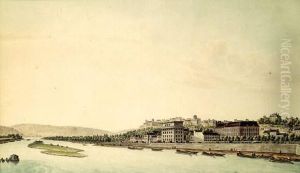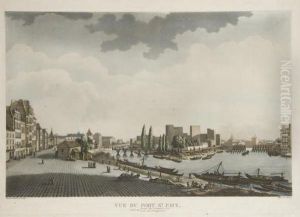Michel Fr. Damane-Demartrais Paintings
Michel Fr. Damane-Demartrais, born in 1763 and died in 1827, was a French artist whose life and work were intricately woven into the fabric of late 18th and early 19th-century French art. Although not as widely recognized as some of his contemporaries, Damane-Demartrais made significant contributions to the art world during a period marked by revolutionary change and the emergence of new artistic movements. His work spanned a variety of mediums, including painting, engraving, and illustration, reflecting the diverse artistic pursuits common among European artists of his time.
The backdrop of Damane-Demartrais's career was a France roiled by political upheaval, from the Revolution of 1789 to the Napoleonic Wars, and finally, the Restoration period. These tumultuous times influenced the themes and methods of artists across Europe, Damane-Demartrais included. He navigated the shifting political and cultural landscapes by adapting his style and subjects to fit the prevailing tastes and ideologies. His ability to do so allowed him to maintain a career in an era when many artists struggled.
Little is known about Damane-Demartrais's early life and training, which is common for many artists of his era. However, his surviving works suggest that he received a strong foundation in classical art principles, likely studying at one of the Royal Academies that were pivotal in shaping French artistic talent. His artistic output includes detailed engravings and illustrations that often featured historical and allegorical themes, popular subjects in the wake of the Revolution.
Despite the scant direct documentation of his life, Damane-Demartrais's contributions can be pieced together through the analysis of his surviving works and the contexts in which they were created. His engravings, characterized by meticulous detail and a keen eye for emotion, serve not only as artistic endeavors but also as historical documents that offer insights into the period's social and political nuances.
Michel Fr. Damane-Demartrais's legacy, while perhaps not as prominent as that of his more famous peers, is preserved in the collections of French museums and in the annals of art history. His work exemplifies the rich tapestry of French art during a period of significant change and showcases the enduring power of visual art to reflect and respond to the world in which it is created. Through his engravings and paintings, Damane-Demartrais remains a figure of interest for those studying the intersections of art, history, and society in post-revolutionary France.


